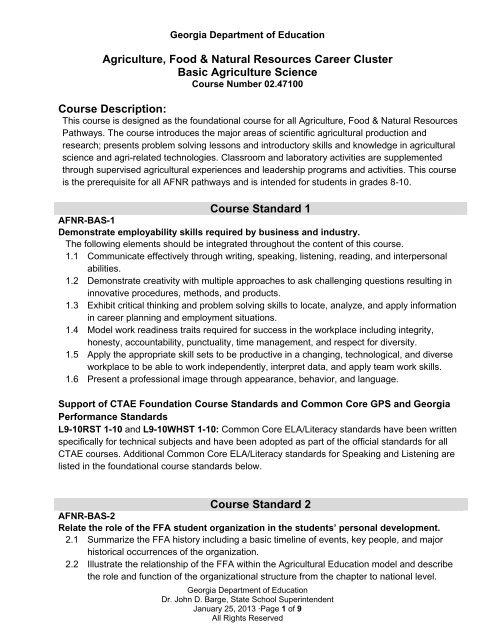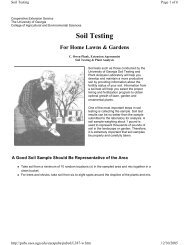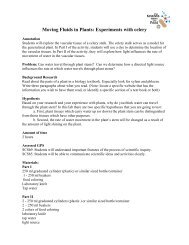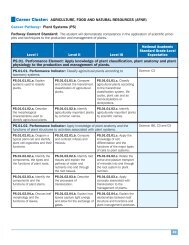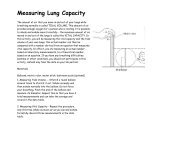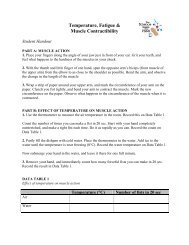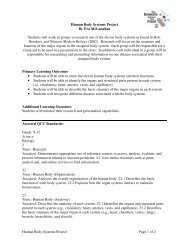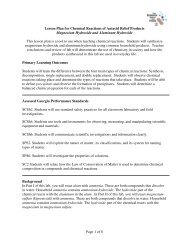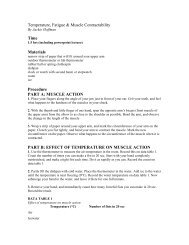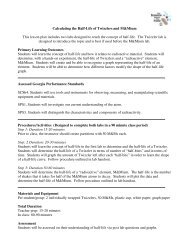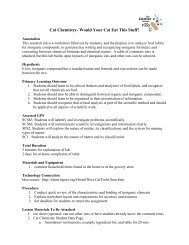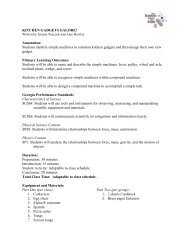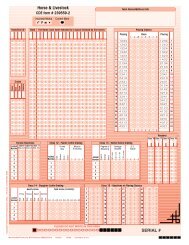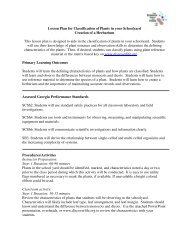Basic Agriculture Science - Georgia Department of Education
Basic Agriculture Science - Georgia Department of Education
Basic Agriculture Science - Georgia Department of Education
Create successful ePaper yourself
Turn your PDF publications into a flip-book with our unique Google optimized e-Paper software.
<strong>Georgia</strong> <strong>Department</strong> <strong>of</strong> <strong>Education</strong><br />
<strong>Agriculture</strong>, Food & Natural Resources Career Cluster<br />
<strong>Basic</strong> <strong>Agriculture</strong> <strong>Science</strong><br />
Course Number 02.47100<br />
Course Description:<br />
This course is designed as the foundational course for all <strong>Agriculture</strong>, Food & Natural Resources<br />
Pathways. The course introduces the major areas <strong>of</strong> scientific agricultural production and<br />
research; presents problem solving lessons and introductory skills and knowledge in agricultural<br />
science and agri-related technologies. Classroom and laboratory activities are supplemented<br />
through supervised agricultural experiences and leadership programs and activities. This course<br />
is the prerequisite for all AFNR pathways and is intended for students in grades 8-10.<br />
Course Standard 1<br />
AFNR-BAS-1<br />
Demonstrate employability skills required by business and industry.<br />
The following elements should be integrated throughout the content <strong>of</strong> this course.<br />
1.1 Communicate effectively through writing, speaking, listening, reading, and interpersonal<br />
abilities.<br />
1.2 Demonstrate creativity with multiple approaches to ask challenging questions resulting in<br />
innovative procedures, methods, and products.<br />
1.3 Exhibit critical thinking and problem solving skills to locate, analyze, and apply information<br />
in career planning and employment situations.<br />
1.4 Model work readiness traits required for success in the workplace including integrity,<br />
honesty, accountability, punctuality, time management, and respect for diversity.<br />
1.5 Apply the appropriate skill sets to be productive in a changing, technological, and diverse<br />
workplace to be able to work independently, interpret data, and apply team work skills.<br />
1.6 Present a pr<strong>of</strong>essional image through appearance, behavior, and language.<br />
Support <strong>of</strong> CTAE Foundation Course Standards and Common Core GPS and <strong>Georgia</strong><br />
Performance Standards<br />
L9-10RST 1-10 and L9-10WHST 1-10: Common Core ELA/Literacy standards have been written<br />
specifically for technical subjects and have been adopted as part <strong>of</strong> the <strong>of</strong>ficial standards for all<br />
CTAE courses. Additional Common Core ELA/Literacy standards for Speaking and Listening are<br />
listed in the foundational course standards below.<br />
Course Standard 2<br />
AFNR-BAS-2<br />
Relate the role <strong>of</strong> the FFA student organization in the students’ personal development.<br />
2.1 Summarize the FFA history including a basic timeline <strong>of</strong> events, key people, and major<br />
historical occurrences <strong>of</strong> the organization.<br />
2.2 Illustrate the relationship <strong>of</strong> the FFA within the Agricultural <strong>Education</strong> model and describe<br />
the role and function <strong>of</strong> the organizational structure from the chapter to national level.<br />
<strong>Georgia</strong> <strong>Department</strong> <strong>of</strong> <strong>Education</strong><br />
Dr. John D. Barge, State School Superintendent<br />
January 25, 2013 ·Page 1 <strong>of</strong> 9<br />
All Rights Reserved
<strong>Georgia</strong> <strong>Department</strong> <strong>of</strong> <strong>Education</strong><br />
2.3 Interpret basic FFA information such as the emblem, colors, motto, mission, salute,<br />
behavior, and <strong>of</strong>ficial dress.<br />
2.4 Demonstrate communication skills individually and within group situations by using public<br />
speaking skills and parliamentary procedure abilities.<br />
2.5 Design personal leadership plan that includes opportunities for personal development<br />
through student, chapter, and community related activities.<br />
Support <strong>of</strong> CTAE Foundation Course Standards and Common Core GPS and <strong>Georgia</strong><br />
Performance Standards<br />
ELACC9-10SL1: Initiate and participate effectively in a range <strong>of</strong> collaborative discussions (oneon-one,<br />
in groups, and teacher-led) with diverse partners on grades 9–10 topics, texts, and<br />
issues, building on others’ ideas and expressing their own clearly and persuasively.<br />
ELACC9-10SL4: Present information, findings, and supporting evidence clearly, concisely, and<br />
logically such that listeners can follow the line <strong>of</strong> reasoning and the organization, development,<br />
substance, and style are appropriate to purpose, audience, and task.<br />
Course Standard 3<br />
AFNR-BAS-3<br />
Explore, develop, and implement the Supervised Agricultural Experience (SAE) program by<br />
researching careers in agriculture and agribusiness.<br />
3.1 Design, implement, and document SAE by recording steps, skills acquired, and financial<br />
information.<br />
3.2 Demonstrate employability skills such as work ethic, timeliness, communication, and selfdirection.<br />
3.3 Explain the role <strong>of</strong> the different types <strong>of</strong> agribusiness in society and identify agribusinesses<br />
in the local community.<br />
3.4 Define agribusiness terminology and discuss the role <strong>of</strong> marketing in agricultural<br />
production.<br />
3.5 Analyze skills, education requirements, income, and advantages and disadvantages <strong>of</strong><br />
careers in the agriculture industry.<br />
Support <strong>of</strong> CTAE Foundation Course Standards and Common Core GPS and <strong>Georgia</strong><br />
Performance Standards<br />
ELACC9-10SL1: Initiate and participate effectively in a range <strong>of</strong> collaborative discussions (oneon-one,<br />
in groups, and teacher-led) with diverse partners on grades 9–10 topics, texts, and<br />
issues, building on others’ ideas and expressing their own clearly and persuasively.<br />
ELACC9-10SL4: Present information, findings, and supporting evidence clearly, concisely, and<br />
logically such that listeners can follow the line <strong>of</strong> reasoning and the organization, development,<br />
substance, and style are appropriate to purpose, audience, and task.<br />
ELACC9-10SL2: Integrate multiple sources <strong>of</strong> information presented in diverse media or formats<br />
(e.g., visually, quantitatively, orally) evaluating the credibility and accuracy <strong>of</strong> each source.<br />
<strong>Georgia</strong> <strong>Department</strong> <strong>of</strong> <strong>Education</strong><br />
Dr. John D. Barge, State School Superintendent<br />
January 25, 2013 ·Page 2 <strong>of</strong> 9<br />
All Rights Reserved
<strong>Georgia</strong> <strong>Department</strong> <strong>of</strong> <strong>Education</strong><br />
Course Standard 4<br />
AFNR-BAS-4<br />
Recognize how agriculture meets human needs today, in the past, and for the future.<br />
4.1 Explain the three basic human needs and sources for food, clothing, and shelter.<br />
4.2 Define agriculture.<br />
4.3 Identify major agricultural milestones or inventions and analyzes their impact on modern<br />
life and agriculture.<br />
4.4 Describe the eight major branches <strong>of</strong> the agriculture industry.<br />
4.5 Determine <strong>Georgia</strong>’s top 10 agricultural commodities.<br />
4.6 Differentiate between agricultural imports and exports and list examples <strong>of</strong> each.<br />
4.7 Compare and contrast between agricultural products and byproducts and lists examples <strong>of</strong><br />
each.<br />
4.8 Identify the top three agricultural commodities within each region <strong>of</strong> the United States and<br />
the world.<br />
Support <strong>of</strong> CTAE Foundation Course Standards and Common Core GPS and <strong>Georgia</strong><br />
Performance Standards<br />
ELACC9-10SL1: Initiate and participate effectively in a range <strong>of</strong> collaborative discussions (oneon-one,<br />
in groups, and teacher-led) with diverse partners on grades 9–10 topics, texts, and<br />
issues, building on others’ ideas and expressing their own clearly and persuasively.<br />
ELACC9-10SL4: Present information, findings, and supporting evidence clearly, concisely, and<br />
logically such that listeners can follow the line <strong>of</strong> reasoning and the organization, development,<br />
substance, and style are appropriate to purpose, audience, and task.<br />
ELACC9-10SL2: Integrate multiple sources <strong>of</strong> information presented in diverse media or formats<br />
(e.g., visually, quantitatively, orally) evaluating the credibility and accuracy <strong>of</strong> each source.<br />
Course Standard 5<br />
AFNR-BAS-5<br />
Determine and illustrate safety in the agriculture lab and agriculture worksites.<br />
5.1 Identify hazards in agricultural education labs and work sites.<br />
5.2 Select safety equipment and procedures for various agriculture related activities.<br />
5.3 Discuss the importance <strong>of</strong> safety in agricultural occupations.<br />
5.4 Demonstrate safety procedures and appropriate behavior while working in the agriculture<br />
classroom, labs, and/or work sites.<br />
Course Standard 6<br />
AFNR-BAS-6<br />
Describe soil formation and management and assess its relevance to plant/animal<br />
production and natural resources management.<br />
6.1 Describe soil formation and soil composition.<br />
6.2 Differentiate between soil components.<br />
6.3 Explain the importance <strong>of</strong> soil ecosystems.<br />
6.4 Analyze the importance <strong>of</strong> slope, soil texture, erosion, and water movement in determining<br />
land capability and land use.<br />
<strong>Georgia</strong> <strong>Department</strong> <strong>of</strong> <strong>Education</strong><br />
Dr. John D. Barge, State School Superintendent<br />
January 25, 2013 ·Page 3 <strong>of</strong> 9<br />
All Rights Reserved
<strong>Georgia</strong> <strong>Department</strong> <strong>of</strong> <strong>Education</strong><br />
6.5 Determine land class on a given site and select appropriate soil management practices.<br />
6.6 Analyze skills, education requirements, income, and advantages and disadvantages <strong>of</strong><br />
careers in agronomy.<br />
Support <strong>of</strong> CTAE Foundation Course Standards and Common Core GPS and <strong>Georgia</strong><br />
Performance Standards<br />
ELACC9-10SL1: Initiate and participate effectively in a range <strong>of</strong> collaborative discussions (oneon-one,<br />
in groups, and teacher-led) with diverse partners on grades 9–10 topics, texts, and<br />
issues, building on others’ ideas and expressing their own clearly and persuasively.<br />
ELACC9-10SL4: Present information, findings, and supporting evidence clearly, concisely, and<br />
logically such that listeners can follow the line <strong>of</strong> reasoning and the organization, development,<br />
substance, and style are appropriate to purpose, audience, and task.<br />
SES3: Students will explore the actions <strong>of</strong> water, wind, ice, and gravity that create landforms and<br />
systems <strong>of</strong> landforms (landscapes).<br />
b. Explain how soil results from weathering and biological processes acting on parent rock.<br />
SEC1: Students will analyze how biotic and abiotic factors interact to affect the distribution <strong>of</strong><br />
species and the diversity <strong>of</strong> life on Earth.<br />
c. Investigate factors that lead to the species richness <strong>of</strong> an ecosystem and describe the<br />
importance <strong>of</strong> biodiversity.<br />
Course Standard 7<br />
AFNR-BAS-7<br />
Demonstrate knowledge <strong>of</strong> physics used in agriculture as it relates to work, power, simple<br />
machines, and both past and present machinery used in the agricultural industry.<br />
7.1 Explain the areas <strong>of</strong> physics used in agriscience as it relates to work, power, simple<br />
machines and mechanical advantage.<br />
7.2 Analyze the use <strong>of</strong> thermal energy, electrical energy and compression in agriculture and<br />
describe basic principles <strong>of</strong> each.<br />
7.3 Trace the development <strong>of</strong> agricultural machinery.<br />
7.4 Interpret service manuals to develop tractor or lawn mower maintenance calendars and<br />
perform basic service and maintenance recommendations on a tractor or lawn mower.<br />
7.5 Demonstrate safe operating instructions and procedures for a tractor or lawn equipment as<br />
recommended by the manufacturer.<br />
7.6 Analyze skills, education requirements, income, and advantages and disadvantages <strong>of</strong><br />
careers in the agricultural mechanics industry.<br />
7.7 Plan and construct basic Agricultural Mechanics project.<br />
Support <strong>of</strong> CTAE Foundation Course Standards and Common Core GPS and <strong>Georgia</strong><br />
Performance Standards<br />
ELACC9-10SL1: Initiate and participate effectively in a range <strong>of</strong> collaborative discussions (oneon-one,<br />
in groups, and teacher-led) with diverse partners on grades 9–10 topics, texts, and<br />
issues, building on others’ ideas and expressing their own clearly and persuasively.<br />
ELACC9-10SL4: Present information, findings, and supporting evidence clearly, concisely, and<br />
logically such that listeners can follow the line <strong>of</strong> reasoning and the organization, development,<br />
substance, and style are appropriate to purpose, audience, and task.<br />
<strong>Georgia</strong> <strong>Department</strong> <strong>of</strong> <strong>Education</strong><br />
Dr. John D. Barge, State School Superintendent<br />
January 25, 2013 ·Page 4 <strong>of</strong> 9<br />
All Rights Reserved
<strong>Georgia</strong> <strong>Department</strong> <strong>of</strong> <strong>Education</strong><br />
Course Standard 8<br />
AFNR-BAS-8<br />
Identify the different areas <strong>of</strong> agriscience and relate the scientific classification system to<br />
organize and research the agriscience field.<br />
8.1 Define biotechnology and create a timeline <strong>of</strong> biotechnology milestones.<br />
8.2 Explain the importance <strong>of</strong> the scientific method in agriculture and list examples <strong>of</strong> current<br />
agriculture research.<br />
8.3 Design, implement, collect data, and determine conclusions by conducting scientific<br />
experiments in any field <strong>of</strong> agriculture.<br />
8.4 Research and report current agricultural biotechnology events or products.<br />
8.5 Analyze skills, education requirements, income, and advantages and disadvantages <strong>of</strong><br />
careers in agriscience/biotechnology fields.<br />
Support <strong>of</strong> CTAE Foundation Course Standards and Common Core GPS and <strong>Georgia</strong><br />
Performance Standards<br />
ELACC9-10SL1: Initiate and participate effectively in a range <strong>of</strong> collaborative discussions (oneon-one,<br />
in groups, and teacher-led) with diverse partners on grades 9–10 topics, texts, and<br />
issues, building on others’ ideas and expressing their own clearly and persuasively.<br />
ELACC9-10SL2: Integrate multiple sources <strong>of</strong> information presented in diverse media or formats<br />
(e.g., visually, quantitatively, orally) evaluating the credibility and accuracy <strong>of</strong> each source.<br />
ELACC9-10SL4: Present information, findings, and supporting evidence clearly, concisely, and<br />
logically such that listeners can follow the line <strong>of</strong> reasoning and the organization, development,<br />
substance, and style are appropriate to purpose, audience, and task.<br />
SCSh3: Students will identify and investigate problems scientifically.<br />
a. Suggest reasonable hypotheses for identified problems.<br />
b. Develop procedures for solving scientific problems.<br />
c. Collect, organize and record appropriate data.<br />
d. Graphically compare and analyze data points and/or summary statistics.<br />
e. Develop reasonable conclusions based on data collected.<br />
f. Evaluate whether conclusions are reasonable by reviewing the process and checking<br />
against other available information.<br />
Course Standard 9<br />
AFNR-BAS-9<br />
Define major components <strong>of</strong> the animal industry and outline the development <strong>of</strong> the<br />
resulting products, services, and careers.<br />
9.1 Analyze the role, importance, and scope <strong>of</strong> the dairy, beef, pork, poultry, equine, and small<br />
ruminant animal industries in modern agriculture.<br />
9.2 Identify and describe major breeds within each livestock segment.<br />
9.3 Explore the importance <strong>of</strong> alternative livestock in animal agriculture.<br />
9.4 Define key terminology related to animal science and production practices (fact vs. fiction).<br />
9.5 Distinguish between animal welfare and animal rights.<br />
9.6 Explain the basic anatomy and label basic external parts <strong>of</strong> production animals.<br />
<strong>Georgia</strong> <strong>Department</strong> <strong>of</strong> <strong>Education</strong><br />
Dr. John D. Barge, State School Superintendent<br />
January 25, 2013 ·Page 5 <strong>of</strong> 9<br />
All Rights Reserved
<strong>Georgia</strong> <strong>Department</strong> <strong>of</strong> <strong>Education</strong><br />
9.7 Differentiate between major wholesale/retail meat cuts <strong>of</strong> beef, pork, lamb, and poultry and<br />
compare the value <strong>of</strong> various meat cuts.<br />
9.8 Analyze skills, education requirements, income, and advantages and disadvantages <strong>of</strong><br />
careers in the animal industry and explain how they differ from traditional on-farm animal<br />
husbandry.<br />
9.9 Provide for the care and welfare <strong>of</strong> animals.<br />
Support <strong>of</strong> CTAE Foundation Course Standards and Common Core GPS and <strong>Georgia</strong><br />
Performance Standards<br />
ELACC9-10SL1: Initiate and participate effectively in a range <strong>of</strong> collaborative discussions (oneon-one,<br />
in groups, and teacher-led) with diverse partners on grades 9–10 topics, texts, and<br />
issues, building on others’ ideas and expressing their own clearly and persuasively.<br />
ELACC9-10SL2: Integrate multiple sources <strong>of</strong> information presented in diverse media or formats<br />
(e.g., visually, quantitatively, orally) evaluating the credibility and accuracy <strong>of</strong> each source.<br />
ELACC9-10SL4: Present information, findings, and supporting evidence clearly, concisely, and<br />
logically such that listeners can follow the line <strong>of</strong> reasoning and the organization, development,<br />
substance, and style are appropriate to purpose, audience, and task.<br />
Course Standard 10<br />
AFNR-BAS-10<br />
Demonstrate basic skills in natural resource management.<br />
10.1 Describe the importance <strong>of</strong> the forestry and natural resource industry to <strong>Georgia</strong>'s<br />
economy.<br />
10.2 Label various parts <strong>of</strong> trees and explain their functions.<br />
10.3 Demonstrate the ability to measure forest products and forest related items.<br />
10.4 Identify basic equipment used in forestry.<br />
10.5 Identify important species <strong>of</strong> trees and wildlife in <strong>Georgia</strong>.<br />
10.6 Explain the relationship between wildlife and the environment.<br />
10.7 Compare and contrast approved practices in managing wildlife.<br />
10.8 Analyze skills, education requirements, income, and advantages and disadvantages <strong>of</strong><br />
careers in the forest and natural resources industry.<br />
Support <strong>of</strong> CTAE Foundation Course Standards and Common Core GPS and <strong>Georgia</strong><br />
Performance Standards<br />
ELACC9-10SL1: Initiate and participate effectively in a range <strong>of</strong> collaborative discussions (oneon-one,<br />
in groups, and teacher-led) with diverse partners on grades 9–10 topics, texts, and<br />
issues, building on others’ ideas and expressing their own clearly and persuasively.<br />
ELACC9-10SL2: Integrate multiple sources <strong>of</strong> information presented in diverse media or formats<br />
(e.g., visually, quantitatively, orally) evaluating the credibility and accuracy <strong>of</strong> each source.<br />
ELACC9-10SL4: Present information, findings, and supporting evidence clearly, concisely, and<br />
logically such that listeners can follow the line <strong>of</strong> reasoning and the organization, development,<br />
substance, and style are appropriate to purpose, audience, and task.<br />
<strong>Georgia</strong> <strong>Department</strong> <strong>of</strong> <strong>Education</strong><br />
Dr. John D. Barge, State School Superintendent<br />
January 25, 2013 ·Page 6 <strong>of</strong> 9<br />
All Rights Reserved
<strong>Georgia</strong> <strong>Department</strong> <strong>of</strong> <strong>Education</strong><br />
Course Standard 11<br />
AFNR-BAS-11<br />
Apply principles <strong>of</strong> science to food processing to provide a safe, wholesome and nutritious<br />
food supply.<br />
11.1 Assess the importance <strong>of</strong> developing and maintaining sanitation standards.<br />
11.2 Explore government requirements and government agencies associated with food quality<br />
and food safety.<br />
11.3 Describe methods <strong>of</strong> food processing, preserving, and packaging.<br />
11.4 Explain the importance <strong>of</strong> food processing, preserving, and packaging.<br />
11.5 Demonstrate the processing, preserving, and packaging <strong>of</strong> foods using various methods<br />
and techniques.<br />
11.6 Analyzes skills, education requirements, income, and advantages and disadvantages <strong>of</strong><br />
careers in the food processing industry.<br />
Support <strong>of</strong> CTAE Foundation Course Standards and Common Core GPS and <strong>Georgia</strong><br />
Performance Standards<br />
ELACC9-10SL1: Initiate and participate effectively in a range <strong>of</strong> collaborative discussions (oneon-one,<br />
in groups, and teacher-led) with diverse partners on grades 9–10 topics, texts, and<br />
issues, building on others’ ideas and expressing their own clearly and persuasively.<br />
ELACC9-10SL2: Integrate multiple sources <strong>of</strong> information presented in diverse media or formats<br />
(e.g., visually, quantitatively, orally) evaluating the credibility and accuracy <strong>of</strong> each source.<br />
ELACC9-10SL4: Present information, findings, and supporting evidence clearly, concisely, and<br />
logically such that listeners can follow the line <strong>of</strong> reasoning and the organization, development,<br />
substance, and style are appropriate to purpose, audience, and task.<br />
Course Standard 12<br />
AFNR-BAS-12<br />
Apply principles <strong>of</strong> environmental science as it relates to agricultural production and<br />
sustainability.<br />
12.1 Identifies agricultural commodities that can be converted to alternative energy sources.<br />
12.2 Analyzes the efficiency <strong>of</strong> renewable energy sources such as wind, solar, and bi<strong>of</strong>uels.<br />
12.3 Compares and contrasts current production practices such as organic, naturally raised<br />
systems, and conventional agricultural production with regard to their sustainability.<br />
12.4 Demonstrates how intensive production systems such as aquaculture and vertical farming<br />
can maximize production while minimizing space requirements.<br />
12.5 Debates how environmental legislation effects agricultural production.<br />
12.6 Analyzes skills, education requirements, income, and advantages and disadvantages <strong>of</strong><br />
careers in the agricultural environmental science industry.<br />
Support <strong>of</strong> CTAE Foundation Course Standards and Common Core GPS and <strong>Georgia</strong><br />
Performance Standards<br />
ELACC9-10SL1: Initiate and participate effectively in a range <strong>of</strong> collaborative discussions (oneon-one,<br />
in groups, and teacher-led) with diverse partners on grades 9–10 topics, texts, and<br />
issues, building on others’ ideas and expressing their own clearly and persuasively.<br />
<strong>Georgia</strong> <strong>Department</strong> <strong>of</strong> <strong>Education</strong><br />
Dr. John D. Barge, State School Superintendent<br />
January 25, 2013 ·Page 7 <strong>of</strong> 9<br />
All Rights Reserved
<strong>Georgia</strong> <strong>Department</strong> <strong>of</strong> <strong>Education</strong><br />
ELACC9-10SL2: Integrate multiple sources <strong>of</strong> information presented in diverse media or formats<br />
(e.g., visually, quantitatively, orally) evaluating the credibility and accuracy <strong>of</strong> each source.<br />
SEV4: Students will understand and describe availability, allocation and conservation <strong>of</strong> energy<br />
and other resources.<br />
a. Differentiate between renewable and nonrenewable resources including how different<br />
resources are produced, rates <strong>of</strong> use, renewal rates, and limitations <strong>of</strong> sources. Distinguish<br />
between natural and produced resources.<br />
b. Describe how technology is increasing the efficiency <strong>of</strong> utilization and accessibility <strong>of</strong><br />
resources.<br />
c. Describe how energy and other resource utilization impact the environment and recognize<br />
that individuals as well as larger entities (businesses, governments, etc.) have impact on<br />
energy efficiency.<br />
d. Describe the relationship <strong>of</strong> energy consumption and the living standards <strong>of</strong> societies.<br />
e. Describe the commonly used fuels (e.g. fossil fuels, nuclear fuels, etc.) and some alternative<br />
fuels (e.g. wind, solar, ethanol, etc.) including the required technology, availability, pollution<br />
problems and implementation problems. Recognize the origin <strong>of</strong> fossil fuels and the problems<br />
associated with our dependence on this energy source.<br />
f. Describe the need for informed decision making <strong>of</strong> resource utilization (i.e. energy and water<br />
usage allocation, conservation, food and land, and long-term depletion).<br />
Course Standard 13<br />
AFNR-BAS-13<br />
Explain and demonstrate basic plant science principles including plant health, growth and<br />
reproduction.<br />
13.1 Describe basic factors in plant growth.<br />
13.2 Identify plant life cycles and list examples.<br />
13.3 Label the major parts <strong>of</strong> the plant and explain functions <strong>of</strong> each plant part.<br />
13.4 Compare and contrast photosynthesis, respiration, and transpiration and state their<br />
importance.<br />
13.5 Identify important floriculture and nursery/landscape plants utilized in <strong>Georgia</strong>.<br />
13.6 Explain the roles <strong>of</strong> essential plant nutrients for plant growth and reproduction.<br />
13.7 Debate the use <strong>of</strong> organic and inorganic fertilizers in plant production.<br />
13.8 Illustrate and demonstrate sexual and asexual methods <strong>of</strong> various plant propagation<br />
techniques.<br />
13.9 Sequence the steps <strong>of</strong> pollination and fertilization.<br />
13.10 Demonstrate scarification, stratification, and planting seeds.<br />
13.11 Outline germination steps and list conditions under which germination occurs.<br />
13.12 Analyze skills, education requirements, income, and advantages and disadvantages <strong>of</strong><br />
careers in the plant science industry.<br />
<strong>Georgia</strong> <strong>Department</strong> <strong>of</strong> <strong>Education</strong><br />
Dr. John D. Barge, State School Superintendent<br />
January 25, 2013 ·Page 8 <strong>of</strong> 9<br />
All Rights Reserved
<strong>Georgia</strong> <strong>Department</strong> <strong>of</strong> <strong>Education</strong><br />
Support <strong>of</strong> CTAE Foundation Course Standards and Common Core GPS and <strong>Georgia</strong><br />
Performance Standards<br />
ELACC9-10SL1: Initiate and participate effectively in a range <strong>of</strong> collaborative discussions (oneon-one,<br />
in groups, and teacher-led) with diverse partners on grades 9–10 topics, texts, and<br />
issues, building on others’ ideas and expressing their own clearly and persuasively.<br />
ELACC9-10SL2: Integrate multiple sources <strong>of</strong> information presented in diverse media or formats<br />
(e.g., visually, quantitatively, orally) evaluating the credibility and accuracy <strong>of</strong> each source.<br />
ELACC9-10SL4: Present information, findings, and supporting evidence clearly, concisely, and<br />
logically such that listeners can follow the line <strong>of</strong> reasoning and the organization, development,<br />
substance, and style are appropriate to purpose, audience, and task.<br />
SBO1: Students will use current plant phylogenetic principles and describe the structural changes<br />
used to delineate the plant divisions.<br />
b. Identify and evaluate plant structures in relation to their functions.<br />
SBO3: Students will explore the structures and processes necessary for the mutual survival <strong>of</strong><br />
plants and animals.<br />
a. Describe and relate plant structures (organs, tissues, cells, organelles) to plant processes<br />
(photosynthesis, respiration, transport, growth, reproduction, dispersal).<br />
SBO5: Students will analyze the diversity <strong>of</strong> plant adaptations and responses to environmental<br />
extremes.<br />
b. Examine plant growth and development in relation to plant hormones and responses to<br />
external signals such as light, gravity, and touch.<br />
<strong>Georgia</strong> <strong>Department</strong> <strong>of</strong> <strong>Education</strong><br />
Dr. John D. Barge, State School Superintendent<br />
January 25, 2013 ·Page 9 <strong>of</strong> 9<br />
All Rights Reserved


